
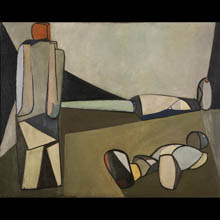
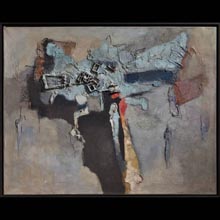

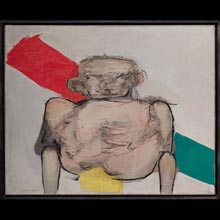
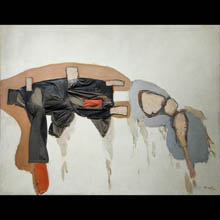
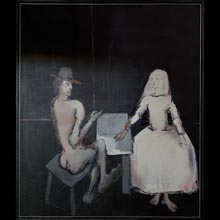
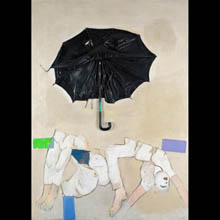
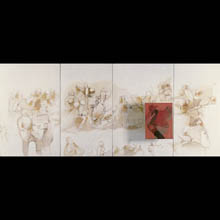
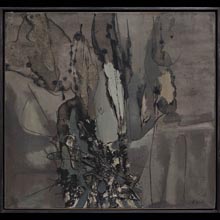
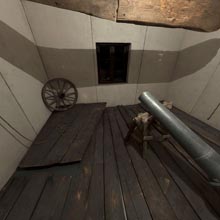
His early interest in art coaxed him into training in the Painting Department of the Krakow Academy of Fine Arts (1934-1939). His former admiration for the symbolism of Young Poland art and new impulses provided by Post-Impressionism, the Kapists’ colour experiments and the cool intellectualism of Cubism and Constructivism met head-on there. During the Nazi occupation Kantor continued his academic painterly experience. However, that period was above all a time of theatre revolution that the productions of his Underground Theatre fuelled.
After the war, painting became his main focus again. In 1946, in keeping with the manifesto of “heightened realism”, which he had drafted together with Mieczysław Porębski (the theoretician of the Group of Young Visual Artists during the war), he started creating pieces on social subjects (A Washerwoman, Bakers), inspired by the Cubist-leaning painting of the Young Painters of the French Tradition, whose works were on view Krakow and Warsaw at that time. But a true turning point in his art came in 1947 with his first trip to Paris, a grant from the Ministry of Culture. Multiple visits to Palais de la Découverte made him realise that the world as seen by the human eye armed with scientific instruments may uncover some new areas of reality for art that are closer to the anxieties of the death-contaminated generation. Also, meetings with the art of the Surrealists, especially the discovery of Robert Matty’s and Wols’s oeuvre, were fairly consequential. On return to Krakow, Kantor painted abstract-and-surrealist paintings he called “metaphorical”, clearly driven by a need which, in some measure, grew out of his desire to find a sense in “a world after a catastrophe”. They were first showed at the First Polish Exhibition of Modern Art he was an initiator and co-organiser of. The rapacious disfigurement of the human body in this series (the last piece was dated 1954; two important ones are in the collection of the National Museum in Krakow) as well as his being always one step away from abstract idealism may be read as an effect of avant-garde formalism clouded by the memory of the cruelty of war-time reality. That art was rejected outright and condemned by doctrinaires of Socialist Realism. Kantor disappeared from the official art scene for a few years, accepting only commissions for stage designs for theatres in Krakow and the near-by Silesia (Katowice, Opole).
Another trip to Paris in 1955 meant another watershed in Kantor’s painting. In Paris, he got attracted by Georges Mathieu’s practice of painting under the viewers’ very eyes. Mathieu played a game with accidentality; for him, just as for Kantor, it was not the final work that counted but the creative process itself. The only protagonist of the pieces Kantor painted in the second half of the 1950s was the painting matter. Unlike other Informel artists, he did not treat a painting as a means of expressing his own emotions and experiences but as an object, no different than, say, a chair. If a painting conveyed anything, it was not so much the artist’s powerful self as the reality of incidence and matter.
In 1964, Tadeusz Kantor wrote a manifesto presenting one of his major concepts: emballage. Emballage, or packaging, appeared as his method to reclaim an object. The packing gesture soon assumed a number of new meanings: as one of very commonplace activities it became a vehicle of ridicule of the prestige of high-brow culture; it gave an opportunity to hide and protect what was endangered; it helped to show the unimaginable or unrepresentable. Kantor understood the idea of emballage very widely, exploiting it till the end of his life in painting (e.g. U. et T. A. Chexbres, 1965; Emballage picturale, 1966; Infanta, Mr V. Prado II, 1965 from the series Museum Persiflages, 1965-1970; Emballages, objets, personages nr 2 1967; The Emballage of “The Prussian Homage” According to Jan Matejko, 1975, commissioned from the artist by the National Museum in Krakow as part of a conference of the International Association of Art Critics (AICA) in the Gallery of 19th-Century Polish Art in the Cloth Hall), “projects impossible”, object art (Self-Portrait, 1977) and in theatre.
In the 1980s Kantor created his last, disturbing series of paintings: There is Nothing More Further On and My Home. In them, the artist summed-up his earlier experiences, and revised his attitude to reality, illusion, avant-garde, the heritage of symbolism, his personal reminiscences and collective memory. What had been opposites before, now revealed their interrelationships: illusion served to reinforce reality; the past turned out to be the only reality; avant-garde, being history itself, did not come up any longer except in recollections, and only a road that took one into the depths of memory was truly avant-garde.
Tadeusz Kantor’s art has three key concepts for its mainstays: AVANT-GARDE REALITY – MEMORY. It seems that it is the presence of these elements, which are intertwined in a multi-thread knot of tensions and relationships, that makes his art so powerful. The permanent state of „dynamic imbalance” between them gives his art a surprisingly coherent look today, despite its enormous diversification, the phases it went through, as well as the idioms and concepts it annexed one after another, covering more and more areas. If looked at from the perspective of the triad above, all his activities, from the first theatre attempts, to the dialogue with the Great Avant-Garde, Informel art, “playing with Witkacy”, happenings, to the 1960s and 1980s experiments, the Death Theatre and his last paintings, though remote from one another in many respects, appear to be chapters of the same story. It is a story where a nostalgia for the avant-garde utopia merges with a fear of its tyranny, memory is both a burden and liberation from the terror of modernity, and reality is the ultimate tribute paid to illusion.
Marek Świca
List of this author's objects:
Metaphorical Picture I • Metaphorical Picture II • Peinture 80. Figure • No. V. Prado II (Infanta) • Head - Emballage – Figure • Emballage V • “One evening the Valazquez’s Infanta entered my room / (for the second time)” • Emballages, objets, personnages 2 • Emballage of the „Prussian Tribute” after Jan Matejko • Composition VII • The Room of Odysseus. Stage designe for Stanisław Wyspianski’s play The Return of Odysseus (premiere: June, 21)













